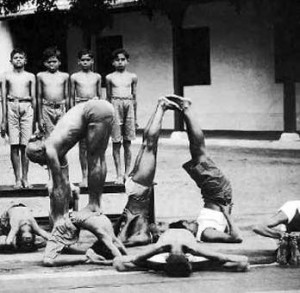Krishnamacharya’s guru had set an ambitious goal for him. The goal was no less than changing the course of human destiny. This was to be accomplished by making hatha-yoga popular. Both Krishnamacharya and his guru viewed hatha-yoga as an entrance or a starting point into the larger yoga. Given the unpopularity of hatha yoga, how was this poor Brahmin boy to accomplish his guru’s wishes? Before we go into this let us take a moment to understand why hatha-yoga was not popular in the first place.
Many thousands of years ago, Patanjali propounded the “8 limbs of yoga”. His work was known as “The Yoga Sutras” and his system of yoga was later known as Raja Yoga. The yoga sutras were written in Sanskrit and contained about 196 sutras or short stanzas or paragraphs. The actual number of sutras varies depending on the source as some stanzas were added or deleted but the number of sutras does not vary by much from the number 196 by more than a few sutras. Thus the integrity of the main body of work of Patanjali has been preserved for thousands of years.
Of the eight limbs of yoga, that Patanjali propounded, asanas was one of them. Unfortunately he did not elaborate much on asanas within the yoga sutra itself. This has led to confusion as to what exactly did Patanjali mean by the word asana? The literal translation of the word “asanam” in Sanskrit is “to be seated”. This has led some to speculate that yoga-asana referred to by Patanjali was only with respect to the seated posture while meditating. After all one cannot meditate successfully if you cannot remain seated comfortably for an extended period. It is not surprising therefore to find that yoga-asana (or the yoga of postures or hatha-yoga) was in serious decline at the start of the 20th century. (The confusion of the meaning of word “asana” is unwarranted. The word “asana” in Sanskrit means posture and “asanam” probably refers to the most common posture: that of being seated. It is thought that Patanjali did not find it necessary to propound on the asana practice as it was widely practiced and common knowledge at that time.)
It is for this reasons that Krishnamacharya’s guru asked him to propagate and spread hatha-yoga throughout the world. He viewed hatha-yoga as a vital limb of the 8 limbs and saw its decline as a threat to the entire system of Raja-yoga. No doubt Krishnamacharya was brilliant and had mastery over the subject. But he was living in poverty in a remote corner of India, utterly devoid of resources and means to carry out the task assigned to him. What made his task even more burdensome is the fact that nobody was interested in doing hatha-yoga. The correlation between the physical and the mental was not at all clear at that time. Hatha-yoga was viewed as a form of physical exercise and consequently viewed as much inferior to the mental and spiritual practice of meditation. Either people were interested in learning the scriptures or practicing meditation. Nobody saw any benefit in doing hatha-yoga. How was then, Krishnamacharya to propagate hatha-yoga?
Krishnamacharya was desperate. To attract attention he resorted to what he would later call as “propaganda”. He would hold demonstrations where he would ask his students to perform extremely difficult and challenging postures. In one of the pictures he is seen as standing on top of one of his student who is doing a backward bend! Later on he would say that these “stunts” were not to be performed by lay people and were done only for the purpose of attracting attention. In fact hatha-yoga like all the 8 limbs of yoga is an inward-oriented practice and is not done for enhancing the ego but instead done for diminishing it. The fact that a yogi of the caliber of Krishnamacharya had to resort to such demonstrations speaks to the level of his desperation.
At one stage, Krishnamacharya even resorted to the stunt of doing a demonstation of stopping his heartbeat for a few minutes. It is not clear what he did, and there is some controversy over the fact whether the heartbeat can actually be stopped. In experiments with other yogis it has been shown that though the EKG continues to show contractions, there is no measurable pulse and heartbeat, probably due to the severe restriction of blood flow to the heart. Whatever may be the case, Krishnamacharya managed to attract attention. Very soon European and American doctors were making a beeline to witness this phenomenon and were able to attest to the fact that they could not hear any heartbeat even using stethoscope.
As Krishnamacharya’s fame spread he managed to attract a small but dedicated number of key students. These students went on to become great teachers in their own right and as a result hatha-yoga spread to all parts of the world. If you practice hatha-yoga today, you must bear in mind, that this may be the result of Krishnamacharya’s propaganda!

